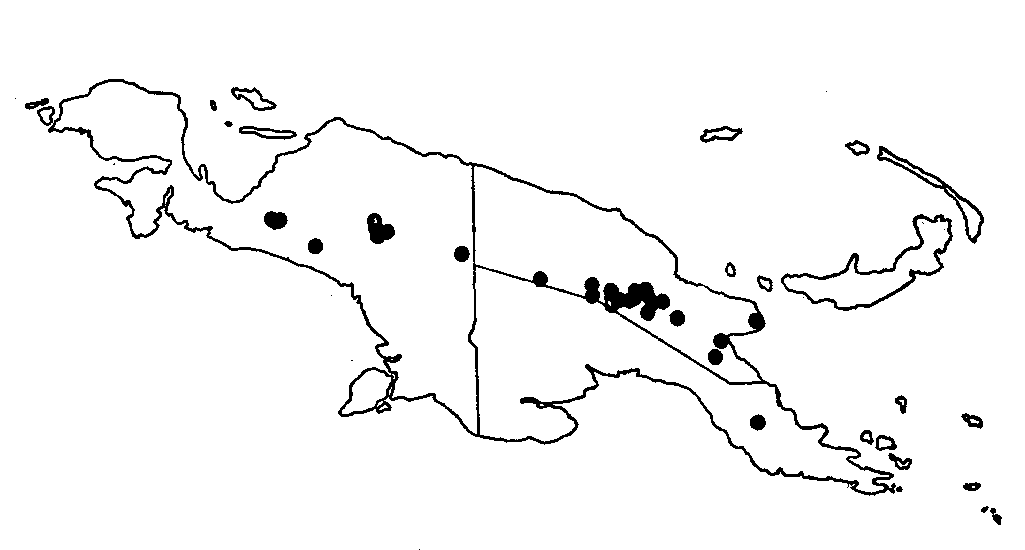
Distribution Map

Description (Barlow 1992)
Loranthus finisterrae Warburg. Bot. Jahrb. Syst. 16 (1893) 20. - Amyema finisterrae (Warburg) Danser. Bull. Jard. Bot. Buitenzorg III, 10 (1929) 295. - Type: Hellwig 322 (B. not extant). New Guinea. Finisterre Mts. 2000 m.
For description and further synonymy see Danser, Bull. Jard. Bot. Buitenzorg III, 11 (1931) 332; Barlow, Austral. J. Bot. 22 (1974) 576. Along with the closely related A. hastifolia, the species is distinct from all its congeners in its inflorescence which is a solitary flower on an articulate 'pedicel'. Amyema finisterrae can be distinguished from A. hastifolia by its smaller, more rounded, more distinctly petiolate leaves and different dimensions of the inflorescence and flower. The flower colour is described as various shades of red from dark pink to purple, frequently having these colours in the lower part and being paler, or green, or yellow above.
The species is common in the highlands of New Guinea at elevations
from l300 to 2600 m (fig. 6; 64 collections seen), in primary
and secondary rain forests, parasitic on various hosts including
Acalypha, Aglaia, Castanopsis, Dimorphanthera, Dodonaea, Ficus,
and Glochidion.
The inflorescence of a solitary flower
on an articulate pedicel represents the extreme of inflorescence
reduction and specialization in the genus. The basal segment is
probably homologous with the peduncle or ray of a more complex
umbellate inflorescence, and the distal one is presumably the
true pedicel of the flower. Amyemafinisterrae and A.
hastifolia are probably directly related young endemics of
the emerging New Guinean highlands, possibly more distantly related
to the A. artensis complex. Whilst the other highland species
of New Guinea mostly have high numbers of flowers in the inflorescence,
adaptation in these two species appears to have favoured production
of flowers sequentially rather than simultaneously.
Description (Barlow 1974)
Amyema finisterrae (Warb.) Dans. Bull. Jard. bot. Buitenz. 10: 295 (1929); 11: 332, illus. Fig. 10, h-l (1931); Loranthus finisterrae Warb. Bot. Jahrb. 16: 20 (1893). Type-Finisterre Mts., 2000 m alt., Hellwig 322 (B, not seen, probably destroyed).
Loranthus diversifolius Ridl. Trans. Linn. Soc. Bot. 9:146 (1916). Type-West Irian, between Camps VIII and IX, Wollaston Exp., Kloss sn., 13.i.1913 (K).
Glabrous. Leaves opposite; petiole 4-7 mm long, distinct but double-edged; lamina (oblong to) elliptical-spathulate (to broad ovate), 1.8-4-(6) by 1.5-3 cm, dull on both sides or somewhat lustrous above, darker above than below, attenuate to contracted at the base, recurved at the, margins, mostly rounded but very rarely acute and acuminate at the apex; venation pennate with the lateral veins diverging near the base of the lamina, indistinct or with only the midrib visible. Inflorescences solitary to few in the axils, each consisting of a single pedicellate flower on a slender ebracteate peduncle 2-4-(6) mm long (i.e. a flower on a jointed 'pedicel'); pedicel slender, wider at the apex, 1.5-3 mm long; with a single bract (rarely 2 or 3) at the apex; bract erect, acute, c. 1.5 mm long. Calyx slightly funnel-shaped; limb truncate or weakly 4-lobed or 4-toothed, membranous, 0.7-l mm long. Corolla in the mature bud quadrangular, more or less winged, sometimes clavate when winged, acute or obtuse, (13)-20-35 mm long, 4-merous. Anthers 2-3 mm long; free parts of the filaments about twice as long. Fruit ellipsoidal to slightly pear-shaped. Chrornosorne Nurnber.- n = 9 (Barlow and Wiens 1971). Voucher: Barlow 96S.
Occurrence. New Guinean mainland (Fig. 6), 1500 to 2600 m altitude.
Representative Specimens. WEST IRIAN: E. foot of Pekeglbaro, Wissel Lakes, 1770 m alt., Vink and Schram BW 8932, 28.v.1960 (L; CANB). EASTERN NEW GUINEA: 7 miles from Kundiawa on road to Kerowagi, 1550 m alt., Barlow 965, 16.ii.1965 (BRIU; AD; L; LAE); Alola, Papua, c. 1850 m alt., Carr 13851, 17.xii.1935 (CANB; LAE).
Amyema finisterrae is
closely related to A. hastifolium (see note under A.
hastifolium). The two species are distinguished from all other
members of the genus except the poorly known A. curvifolium
by the extreme reduction of the inflorescence from an umbel
of triads (or tetrads) to a single flower on an articulate pedicel
(see note under genus Amyema and also Barlow 1966, p. 453).
The occasional occurrence of 2 or 3 bracts under the flower suggests
that the solitary flower may be a reduced triad.
Illustrations
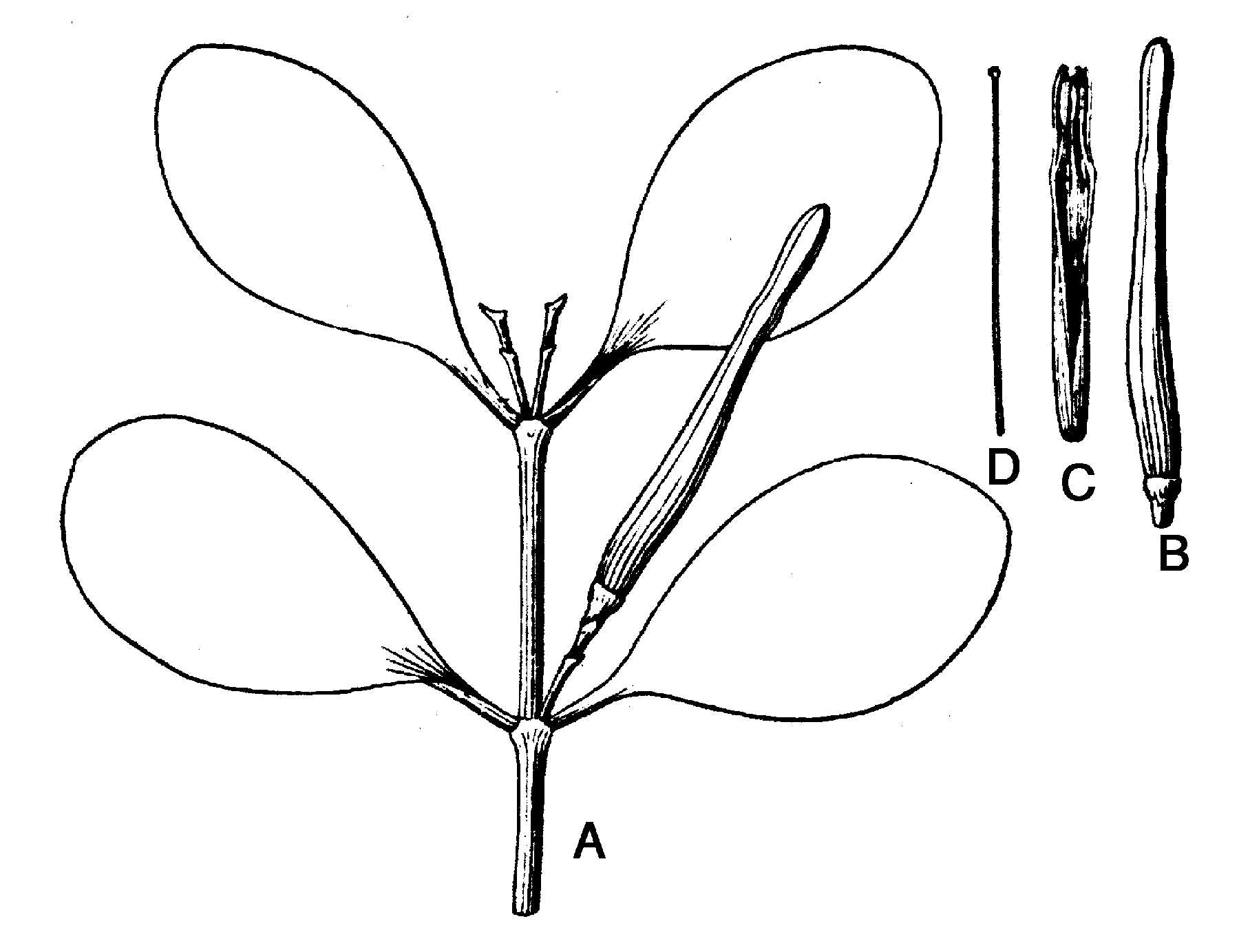
Amyema finisterrae. A - twig with leaves and inflorescences B - flower bud. C - corolla cut open at one side. D - style. From Danser (1931).
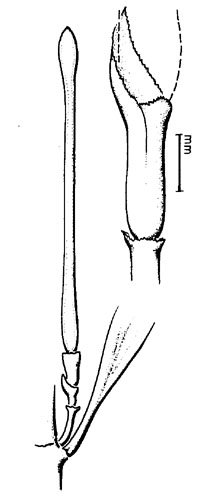
A unifloral inflorescence. From Kuijt (1981)
Photographs
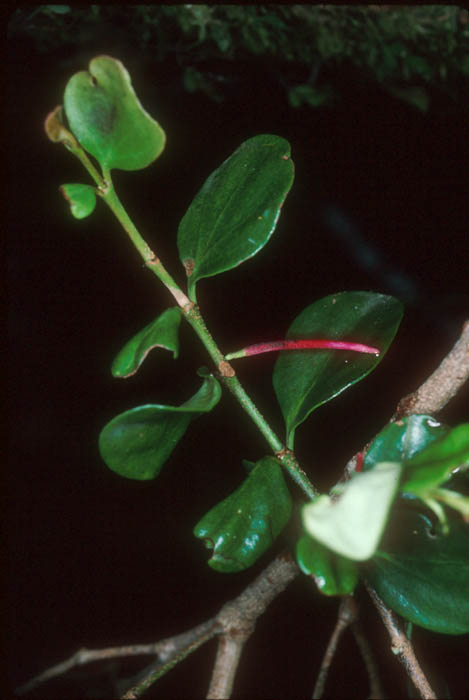
Amyema finisterrae (DLN 4493). Plant showing the single flowered inflorescence. Gumi logging area, Papua New Guinea. Photo by Dan Nickrent.
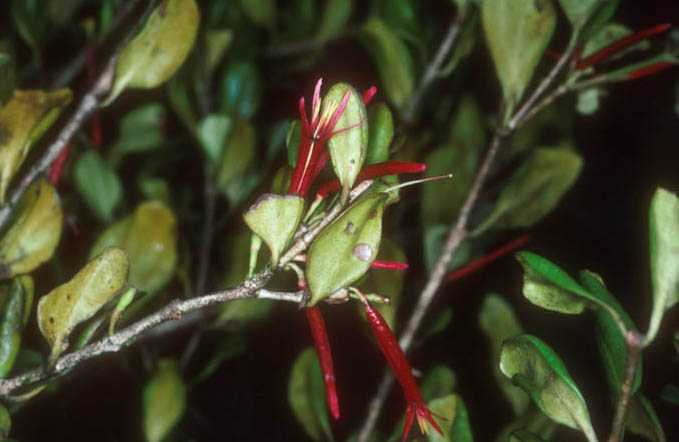
Amyema finisterrae (DLN 4497). Along road to Oiwa, Papua New Guinea. Note the distinctly bifacial leaves, whitish beneath and glossy green above. Photo by Dan Nickrent.
Amyema finisterrae
updated 18 January 2007